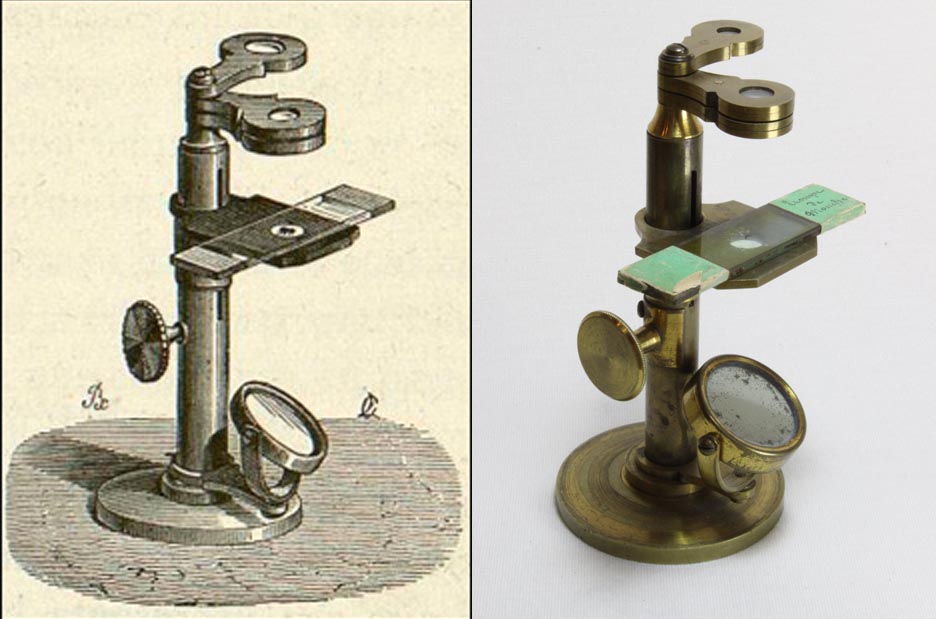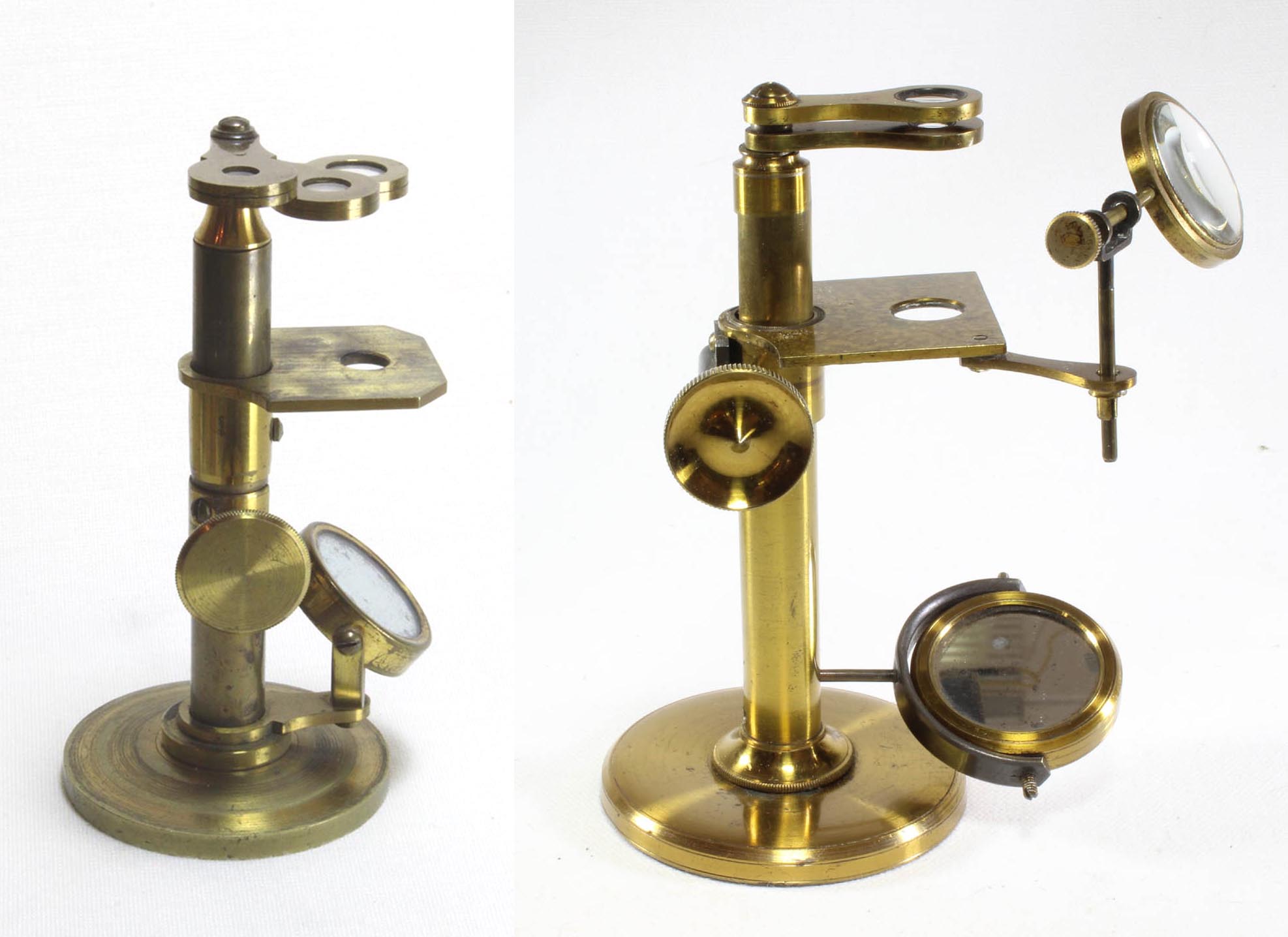MICROSCOPE-ANTIQUES.COM © 2013-16.
MODEL: ?
DATE: c. Last 1/3 19th C.
MAKER: unknown
UNSIGNED
SERIAL NUMBER: None
COUNTRY OF ORIGIN: FRANCE
DESCRIPTION:
This botanical microscope, superficially similar to another in this collection, arises from a circular brass foot which supports the round pillar.
The mirror is supported by a tab from a ring which surrounds the pillar. There is rack and pinion focusing to the stage via a single knob acting inside the pillar. Unlike the other example, the rack is hidden inside the pillar. There are three swinging lenses at the top of the inner pillar which can be used singly or in combination. The stage has a flat finish with no holes or provision for attachments. The lead-filled base measures 54 mm in diameter. The height of the instrument from top to bottom is about 114 mm (4 and 1/2 inches).
HISTORY OF SIMILAR BOTANICAL MICROSCOPES

 'Botanical Pocket' microscopes were very popular in the 18th and 19th centuries. They ranged from simple hand-held magnifiers to portable stands like this one. Fitting into a small case, this instrument might still qualify as a 'Pocket Microscope.'
There are many similar such 'botanical' microscopes in this collection. At first glance, this example bears close resemblance to another example in this collection. As can be seen in the comparison to the right, there are many subtle differences. The mounting of the mirror
in this one is on a protruding tab from a ring surrounding the pillar, while on the other example, the mirror gimbal is attached to a pin which fits through a hole in the pillar.
The other example has two lenses, whereas this example has three. The rack and pinion in this one are is enclosed inside the pillar, whereas in the other example there is a traditional pinion box. This example has a single sided mirror, whereas the other example has a double sided one, with one side being a chalk reflector. Also note the bullseye on the other example but no provision for it on this one. Finally, the stage has strongly chamfered corners on this one, but the stage on the other is closer to having 90 degree corners. I would note that this example is somewhat heavier than the other example. The similarity of these two microscopes, apparently made by different manufacturers, likely attests to the popularity of the design. This microscope shares many features in common with another microscope in this collection which is box-mounted, though the lenses are separate rather than permanently attached, in that example. More than toys, but less than research microscopes, the instruments by this French maker are all of relatively high quality and produce good images.
'Botanical Pocket' microscopes were very popular in the 18th and 19th centuries. They ranged from simple hand-held magnifiers to portable stands like this one. Fitting into a small case, this instrument might still qualify as a 'Pocket Microscope.'
There are many similar such 'botanical' microscopes in this collection. At first glance, this example bears close resemblance to another example in this collection. As can be seen in the comparison to the right, there are many subtle differences. The mounting of the mirror
in this one is on a protruding tab from a ring surrounding the pillar, while on the other example, the mirror gimbal is attached to a pin which fits through a hole in the pillar.
The other example has two lenses, whereas this example has three. The rack and pinion in this one are is enclosed inside the pillar, whereas in the other example there is a traditional pinion box. This example has a single sided mirror, whereas the other example has a double sided one, with one side being a chalk reflector. Also note the bullseye on the other example but no provision for it on this one. Finally, the stage has strongly chamfered corners on this one, but the stage on the other is closer to having 90 degree corners. I would note that this example is somewhat heavier than the other example. The similarity of these two microscopes, apparently made by different manufacturers, likely attests to the popularity of the design. This microscope shares many features in common with another microscope in this collection which is box-mounted, though the lenses are separate rather than permanently attached, in that example. More than toys, but less than research microscopes, the instruments by this French maker are all of relatively high quality and produce good images.

 'Botanical Pocket' microscopes were very popular in the 18th and 19th centuries. They ranged from simple hand-held magnifiers to portable stands like this one. Fitting into a small case, this instrument might still qualify as a 'Pocket Microscope.'
There are many similar such 'botanical' microscopes in this collection. At first glance, this example bears close resemblance to another example in this collection. As can be seen in the comparison to the right, there are many subtle differences. The mounting of the mirror
in this one is on a protruding tab from a ring surrounding the pillar, while on the other example, the mirror gimbal is attached to a pin which fits through a hole in the pillar.
The other example has two lenses, whereas this example has three. The rack and pinion in this one are is enclosed inside the pillar, whereas in the other example there is a traditional pinion box. This example has a single sided mirror, whereas the other example has a double sided one, with one side being a chalk reflector. Also note the bullseye on the other example but no provision for it on this one. Finally, the stage has strongly chamfered corners on this one, but the stage on the other is closer to having 90 degree corners. I would note that this example is somewhat heavier than the other example. The similarity of these two microscopes, apparently made by different manufacturers, likely attests to the popularity of the design. This microscope shares many features in common with another microscope in this collection which is box-mounted, though the lenses are separate rather than permanently attached, in that example. More than toys, but less than research microscopes, the instruments by this French maker are all of relatively high quality and produce good images.
'Botanical Pocket' microscopes were very popular in the 18th and 19th centuries. They ranged from simple hand-held magnifiers to portable stands like this one. Fitting into a small case, this instrument might still qualify as a 'Pocket Microscope.'
There are many similar such 'botanical' microscopes in this collection. At first glance, this example bears close resemblance to another example in this collection. As can be seen in the comparison to the right, there are many subtle differences. The mounting of the mirror
in this one is on a protruding tab from a ring surrounding the pillar, while on the other example, the mirror gimbal is attached to a pin which fits through a hole in the pillar.
The other example has two lenses, whereas this example has three. The rack and pinion in this one are is enclosed inside the pillar, whereas in the other example there is a traditional pinion box. This example has a single sided mirror, whereas the other example has a double sided one, with one side being a chalk reflector. Also note the bullseye on the other example but no provision for it on this one. Finally, the stage has strongly chamfered corners on this one, but the stage on the other is closer to having 90 degree corners. I would note that this example is somewhat heavier than the other example. The similarity of these two microscopes, apparently made by different manufacturers, likely attests to the popularity of the design. This microscope shares many features in common with another microscope in this collection which is box-mounted, though the lenses are separate rather than permanently attached, in that example. More than toys, but less than research microscopes, the instruments by this French maker are all of relatively high quality and produce good images.